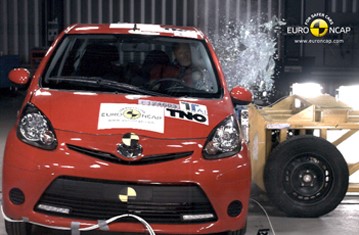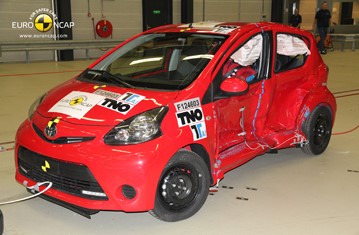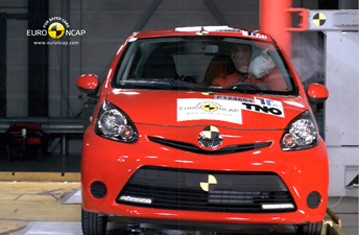Find more information in the General Comments section of the assessment
Find more information in the Rating Validity tab of the assessment
- See More
- See More
- See More
- See More
- Good
- Adequate
- Marginal
- Weak
- Poor
 Passenger
Passenger
 Driver
Driver
 Front Seat
Front Seat
 Car
Car
 Pole
Pole
- Good
- Adequate
- Marginal
- Weak
- Poor


Passenger
outboard
center
Fitted to the vehicle as standard
Not fitted to the test vehicle but available as option
Not Available
Based on dummy readings in the frontal and side tests, the car scored maximum points for its protection of the 3 year infant. That dummy was sat in a forward-facing seat, using ISOFIX anchorages which are not currently standard equipment but which will become so in July 2013. Forward movement of the head was not excessive and, in the side impact, both dummies were properly contained by the shells of their restraints, minimising the likelihood of head contact with parts of the car interior. The passenger airbag can be disabled to allow a rearward-facing child restraint to be used in that seating position. However, information provided to the driver regarding the status of the airbag is not clear and the system was not rewarded. The dangers of using a rearward-facing restraint in that seating position without first disabling the airbag are clearly indicated on the inside of the car.
- Good
- Adequate
- Marginal
- Weak
- Poor

Head Impact 13.2 Pts
Pelvis Impact 0.0 Pts
Leg Impact 6.0 Pts
The bumper scored maximum points, providing good protection to pedestrians' leg in all areas tested. However, the front edge of the bonnet was poor and scored no points. In most areas likely to be struck by the head of a child or of an adult, protection was poor or marginal with some areas offering good protection.
- Good
- Adequate
- Marginal
- Weak
- Poor
| System Name | ESP | |
| Performance | ||
| Vehicle Yaw Rate @ COS + 1.00 s | 1.87% | meets ECE requirements |
| Vehicle Yaw Rate @ COS + 1.75 s | 1.75% | meets ECE requirements |
| Lateral Displacement @ BOS + 1.07 s | 3.01 m | meets ECE requirements |
Electronic stability control is currently optional on some variants but becomes standard equipment on all variants in July 2013. The system met Euro NCAP's test requirements. A seatbelt reminder is standard equipment now but a passenger reminder does not become standard until July 2013. The systems met Euro NCAP's requirements. A reminder for the rear seat belts is not available and there is no speed limitation device on the C1.
- Specifications
- Safety Equipment
- Videos
- Rating Validity
Specifications
Tested Model Toyota Aygo 1.0 High Grade, LHD
Body Type - 5 door hatchback
Year Of Publication 2012
Kerb Weight 845kg
VIN From Which Rating Applies - see comments
Class City and Supermini
Safety Equipment
Note: Other equipment may be available on the vehicle but was not considered in the test year.
Fitted to the vehicle as standard
Fitted to the vehicle as option
Not fitted to the test vehicle but available as option
Not Available
Not Applicable
Videos
Rating Validity


Find more information in the General Comments section of the assessment
 Share
Share









In terms of frontal impact performance, the current C1 is the same as the car tested in 2005 and the results of that test have been used here. The passenger compartment remained stable in the frontal test. However, the driver’s chest struck the steering wheel during the impact and the score for that body region was penalised. Dummy readings indicated good protection of the knees and femurs of both the driver and passenger. However, inspection of the dashboard showed that some structures might pose a risk of injury to occupants of different sizes and to those sat in different positions. There was little deformation at the footwell but testers noted that the brake pedal was displaced rearward and was blocked, increasing the risk of injury to the driver’s lower legs and feet. In the side barrier and more severe side pole impacts, the car was equipped with side impact head and thorax airbags which are available as an option now on some variants but become standard on all variants in July 2013. In both tests, dummy readings indicated marginal protection of the chest. The seat and head restraints provided poor protection against whiplash injury in the event of a rear-end collision.